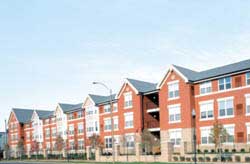![]()
ALUMNI MAGAZINE
AUGUST 1999
| FEATURES | ||
| LETTERS | ||
| AROUND TAPPAN SQUARE | ||
| A STUDENT PERSPECTIVE | ||
| HISTORIAN'S NOTEBOOK | ||
| ALUMNI NEWS | ||
| THE BEAR NECESSITIES | ||
| ONE MORE THING | ||
| STAFF BOX |
Rebuilding a Neighborhood--Inside and Out
Story by Anne Kessen Lowell '81
 |
|
It's
not just housing that Richard Baron '64 considers
when developing safe, affordable properties
in neglected urban neighborhoods, but the human
needs as well. McCormack House in St. Louis
(below) offers special resources for its senior
residents, such as meals and personal care.
|
An Oberlin student with a history of community service, Detroit native Richard Baron penetrated the 1960s Hough neighborhood to volunteer in its newly formed freedom schools. The experience was powerful, and he returned to Hough two decades later with a building project that sparked a housing resurgence and new attempts at the area's restoration.
As president of the St. Louis-based McCormack Baron & Associates, Inc., Baron '64 is recognized nationally for leading the development of affordable, innovative housing in abandoned urban neighborhoods. He founded the firm in 1973 with his late friend and colleague, Terry McCormack, and has since built more than 8,000 housing units in 22 cities at a cost of $670 million. His holistic approach to neighborhood development, linked with his push to involve residents in the design, development, and management of their living spaces, sets him apart from builders with similar agendas. His firm's mission, he says, is "community building."
 A
successful McCormack Baron project requires grass-roots
activism, vision, and development expertise--an outlook
embraced by those in the two-mile Hough neighborhood.
Cleveland Councilwoman Fannie M. Lewis remembers leading
Baron on a midnight tour of the area when he recognized
its potential as a vibrant city neighborhood. "It
looked like Beirut," says Lewis. "I asked him if he
could do his project here. He took one look at the
site and assured me it could happen."
A
successful McCormack Baron project requires grass-roots
activism, vision, and development expertise--an outlook
embraced by those in the two-mile Hough neighborhood.
Cleveland Councilwoman Fannie M. Lewis remembers leading
Baron on a midnight tour of the area when he recognized
its potential as a vibrant city neighborhood. "It
looked like Beirut," says Lewis. "I asked him if he
could do his project here. He took one look at the
site and assured me it could happen." Baron says the mixed-income approach is critical, both economically and socially. Inner-city projects can't be supported by rent subsidies alone, and the market rate units support a crucial layer of private first-mortgage financing.
Equally important is the social impact of economic integration. Neighborhoods suffering from high unemployment and struggling schools find that the cross-section of families provides role models for kids from homes where adults don't work. The mix also ensures that the private sector will bring in its services--retail, recreational, and health.
Among the company's showpieces is Westminster Place in St. Louis. In 1983, Baron tackled a Gaslight Square locale nicknamed "The Stroll" for its once thriving prostitution business. For years the vicinity's only traffic--pedestrian or vehicle--was engaged in illegal activity.
A creative combination of tax credits, bank financing, private equity, and ever-present vision helped create more than 400 brick townhomes and apartments with manicured front lawns, decorative facades, and wide sidewalks that invite children and families. A playground, community pool, and landscaped parks are within walking distance of a shopping center with a supermarket, video store, and service businesses.
Beth Stohr, vice president of Mercantile Bank, a major financier of McCormack Baron projects. "He takes the one next step needed to build a successful community." In St. Louis, that describes two developments created especially for the city's oldest and youngest populations. McCormack House, a 96-unit assisted living complex for low-income, elderly residents, anchors the eastern end of Westminster Place. It resembles a retirement home for the well-to-do: a tall brick portico, natural gas fireplace in the lobby, contemporary artwork in the hallways, and comfortable, bright apartments. But McCormack House was built for people with few resources. "Just because you have reached the end of your life and don't have a great deal of money, doesn't mean you don't deserve a nice place to live," says Manager Jeanette Langton.
Most residents rely on McCormack House's supportive services--assistance with personal care and medications, housekeeping, laundry, and meals in the wood-paneled dining room--at a nominal fee. Resident June Toth enjoys the camaraderie of the place and rattles off names of several friends she has met in her four months there. The only hard part, she says, is not being as independent as she once was. "That's okay," she laughs. "They're taking care of me here."